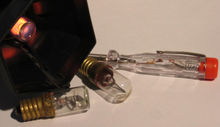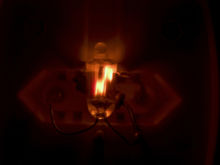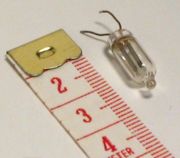Neon lamp

A neon lamp is a gas discharge lamp containing primarily neon gas at low pressure. The term is also used for similar devices filled with other noble gases, usually to produce different colors.
Description
A small electric current, which may be AC or DC, is passed through the tube, causing it to glow orange-red. The exact formulation of the gas is typically the classic Penning mixture, 99.5% neon and 0.5% argon, which has lower striking voltage than pure neon.

Neon lamps are negative resistance devices, where increasing the current flow through the device increases the number of ions, thereby decreasing the resistance of the lamp and allowing increased current to flow. Because of this, the electrical circuitry external to the neon lamp must provide a means to limit the current flow in the circuit or else the current will increase until the neon lamp destroys itself. For indicator-sized lamps, a resistor is conventionally used to limit the current flow. For sign-sized lamps, the high voltage transformer usually limits the available current, often by its having a large amount of leakage inductance in the secondary winding.
When the current through the lamp is lower than the current for the highest-current discharge path, the glow discharge may become unstable and not cover the entire surface of the electrodes. This may be a sign of aging of the indicator bulb, and is exploited in the decorative "flicker flame" neon lamps. However, while too low a current causes flickering, too high a current increases the wear of the electrodes by stimulating sputtering, which coats the internal surface of the lamp with metal and causes it to darken.

The flickering effect is caused by the differences of the ionization potential of the gas, which depends on spacing of the electrodes, the temperature and the pressure of the gas. The potential needed to strike the discharge is higher than what is needed to sustain the discharge. When there is not enough current to ionize the entire volume of the gas around the electrodes, only partial ionization occurs and the glow forms around only part of the electrode surface. The convective currents make the glowing areas flow upwards, not unlike the discharge in a Jacob's ladder. A photoionization effect can be observed here, as the electrode area covered with the discharge can be increased by shining light at the lamp.
Applications

Most small neon (indicator-sized) lamps, such as the common NE-2, breakdown at between 90 and 110 volts. This feature enables their use as very simple voltage regulators or overvoltage protection devices. In the 1960s General Electric (GE), Signalite, and other firms made special extra-stable neon lamps for electronic uses. They even devised digital logic circuits, binary memories, and frequency dividers using neons. Such circuits appeared in electronic organs of the 1950s, as well as some instrumentation.
Small neon lamps are used as indicators in electronic equipment. Larger lamps are used in neon signage. Neon lamps, due to their low current consumption, are good as nightlights. Because of their comparatively fast response time, in the early development of television neon lamps were used as the light source in many mechanical-scan TV displays. They were also used for a variety of other purposes; since a neon lamp can act as a relaxation oscillator with an added resistor and capacitor, it can be used as a simple flashing lamp or audio oscillator. Neon lamps with several shaped electrodes are used as alphanumerical displays known as Nixie tubes.
In AC-excited lamps, both electrodes produce light, but in a DC-excited lamp, only the negative electrode glows. Thus a neon lamp can be used to distinguish between AC and DC sources and to ascertain the polarity of DC sources.
Indicator-sized lamps can also be filled with argon or xenon rather than neon, or mixed with it. While most operating characteristics remain similar, the lamps light with a bluish glow (including some ultraviolet) rather than neon's characteristic reddish-orange glow; the UV radiation then can be used to excite a phosphor coating of the inside of the bulb and provide a wide range of various colors, including white. A mixture of neon and krypton can be used for green glow.
History
Nikola Tesla displayed his neon lights at the World's Columbian Exposition in 1893. His innovations in this type of light emission were not regularly patented. Georges Claude invented a neon lamp in 1902, and displayed it in public in 1910.
